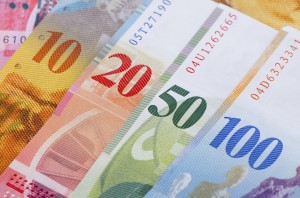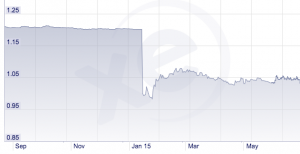A brief guide to CHF – The Swiss Franc
 Whether it’s as the backdrop for the unfolding FIFA scandal or as the target of policymakers keen to be seen taking a hard line on tax evasion, when Switzerland hits the headlines, it tends to be for the wrong reasons.
Whether it’s as the backdrop for the unfolding FIFA scandal or as the target of policymakers keen to be seen taking a hard line on tax evasion, when Switzerland hits the headlines, it tends to be for the wrong reasons.
From a reputational standpoint, Switzerland is in many ways a victim of its own success. It’s no accident that a grand total of 45 international sports associations are based in the country. Situated at the heart of Europe but traditionally distanced from international dramas (not to mention militarily neutral), boasting a highly educated workforce, stable economy and advantageous tax laws: it ticks a lot of boxes. And it’s not just international bodies and deposit account holders who are drawn to it: much like the country itself, the Swiss Franc (CHF) has long had a reputation as a “safe haven” among currencies.
Here’s an overview of why CHF matters and an assessment of what the near future may have in store for it…
What is the Swiss Franc for?
CHF is the sixth most traded currency in the world, accounting for around 6.4% of daily transactions. Traditionally, the country has enjoyed steady economic growth and relatively low inflation rates; factors that help to explain a distinct absence of volatility (historically, at least) when it comes to the performance of CHF on the currency markets.
Its role as an investment currency is tied inextricably with the Swiss banking sector. According to the Swiss Bankers Association, the country enjoys more than a quarter of the world’s cross-border private banking. Granted, by no means are all assets managed by Swiss banks held in CHF, but a significant proportion are.
Then there’s the Swiss Franc’s role as a trading currency. Partly, this is down to the fact that the country hosts the headquarters of so many international companies, leading to a tendency to use the Franc for transactions in many circumstances. A combination of low interest rates and stability mean that the Franc is one of the currencies of choice for the carry trade (especially carry trades involving the Euro or Sterling) – i.e. where traders borrow money in one currency with a very low interest rate and use this to buy government debt in a currency with higher rates.
The Swiss Franc and the Euro: the story pre January 2015
Switzerland may have a historical reputation for neutrality – but, in economic terms, cannot help being closely intertwined with its European neighbours. As an illustration of this, there are more than 100 bilateral agreements in place between Switzerland and the EU in addition to a relatively free flow of labour between the two. In short, when Europe is suffering, Switzerland does not escape the effects.
So how have the Swiss National Bank and government responded to the saga of the Euro crisis over recent years? A glance at the 5-year CHF/Euro chart provides a big clue. For traders looking for a safe haven from the Euro’s woes, the realisation was that CHF would be a natural choice with potentially severe consequences for the country’s exporters (55% of exports are to the Eurozone).
The SNB’s policy to counter a damagingly high Franc came in 2011 with the imposition of a currency ceiling, maintaining an upper limit on CHF at a little over E0.83, driving the Franc to parity with the Euro. This policy involved the SNB swelling its coffers with foreign assets: mostly the Euro and USD, in addition to the Yen, Sterling and Canadian Dollar.
As the 5-year chart shows, this policy ushered in a prolonged period of certainty so far as CHF trading was concerned: the only ‘fundamental’ that seemed to apply to the Franc was the fact that come what may, the SNB would ensure it would remain within a tightly defined window.
So what changed earlier this year?
 The policy couldn’t last forever – and with no end to the Euro’s problems in sight, something had to give. For one thing, keeping a currency artificially low by buying up foreign assets is an expensive business and by November 2014, the SNB held assets equivalent to 80% of annual Swiss economic output. Soaring property prices were another consequence of this policy.
The policy couldn’t last forever – and with no end to the Euro’s problems in sight, something had to give. For one thing, keeping a currency artificially low by buying up foreign assets is an expensive business and by November 2014, the SNB held assets equivalent to 80% of annual Swiss economic output. Soaring property prices were another consequence of this policy.
The about-turn came in mid-January, when the SNB suddenly removed the cap, allowing CHF to soar immediately by 30% against the Euro. The move was made with long-term stability and inflation targets in mind – but the medicine left a bitter taste initially; causing the Swiss stock market to plummet by 10% and throwing Euro/CHF trading into disarray.
What this means for binary options forex traders…
For new traders looking at the Franc, there is now a new landscape. 2014 had seen an annual increase in the level of exports of 4.1%. Bloomberg suggested recently that although the country is expected to escape slipping into recession, the growth figures have changed starkly. Output rose by just 0.1% in the first quarter and declined 0.2% in the second. Growth is expected to return later in the year, and the annual growth rate by the end of the year should hit the 0.9% mark. This broadly mirrors an earlier IMF estimate of 0.75% growth for the year.
Without a ceiling in the equation, CHF now moves in line with the prevailing climate – which means looking closely at the fundamentals. The IMF suggested that the Franc is currently overvalued so do not be surprised to see it close the year several points lower than its current level. Intra-month, week and year, pay special attention to the following:
- Any bouts of global risk aversion (including, for instance, an escalation of the Brexit crisis) which may send investors flocking to the Franc as a safe haven.
- Evidence of new uncertainties about Swiss/EU relations. The discourse in Switzerland has taken an anti-immigration tone recently. Look out for any indications of policy shifts that could threaten Swiss firms’ access to EU markets.
- Export figures. Any announcements suggesting Swiss exporters are learning to adapt to the new currency climate quicker than was anticipated are likely to have an upward effect on the Franc.
- “Lifting the lid” on the banking sector.2014 was a year of fines and litigation for the Swiss banking system. The line is that the country has got its house in order in terms of regulation and supervision. However, with the country once again in the spotlight (thanks in no small part to Sepp Blatter and his friends), do not rule out fresh attacks on a perceived culture of secrecy which, given the importance of the financial sector to the economy as a whole, could have short-term ramifications for CHF.